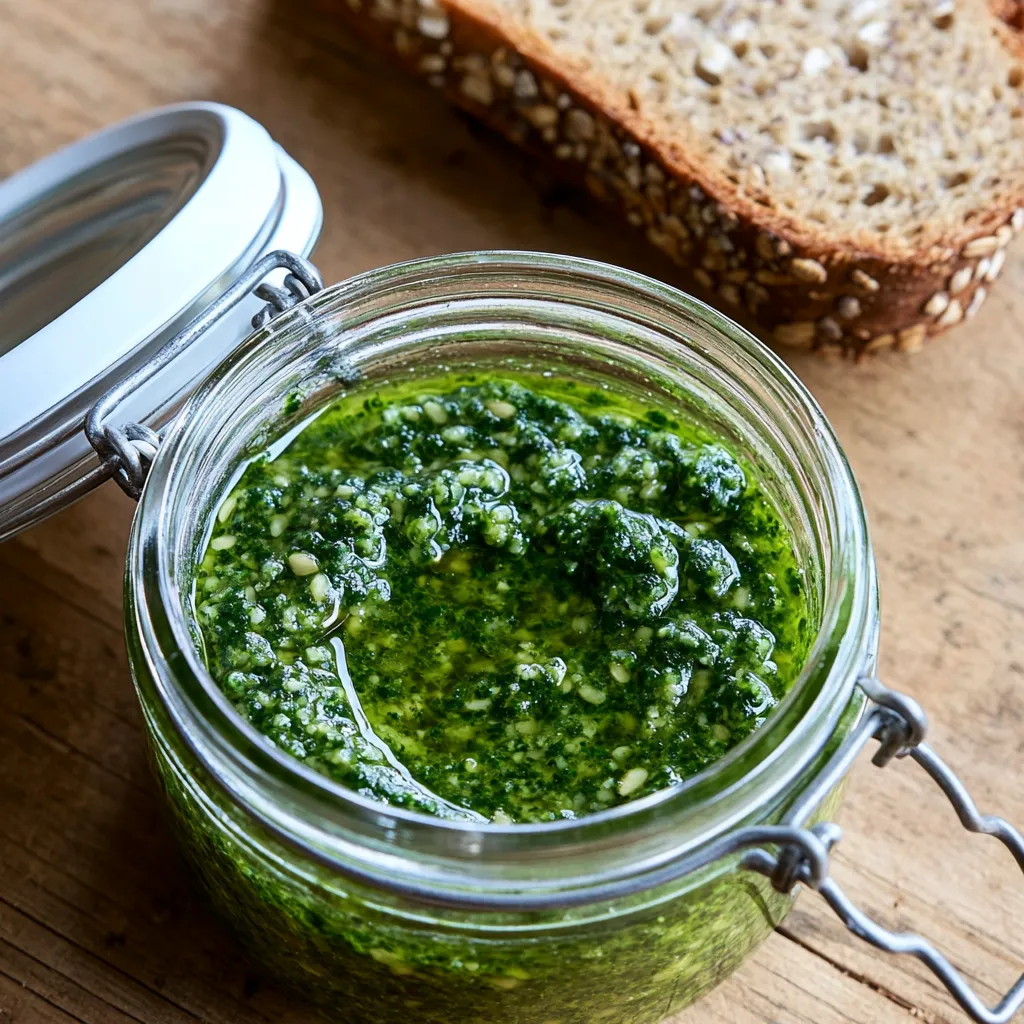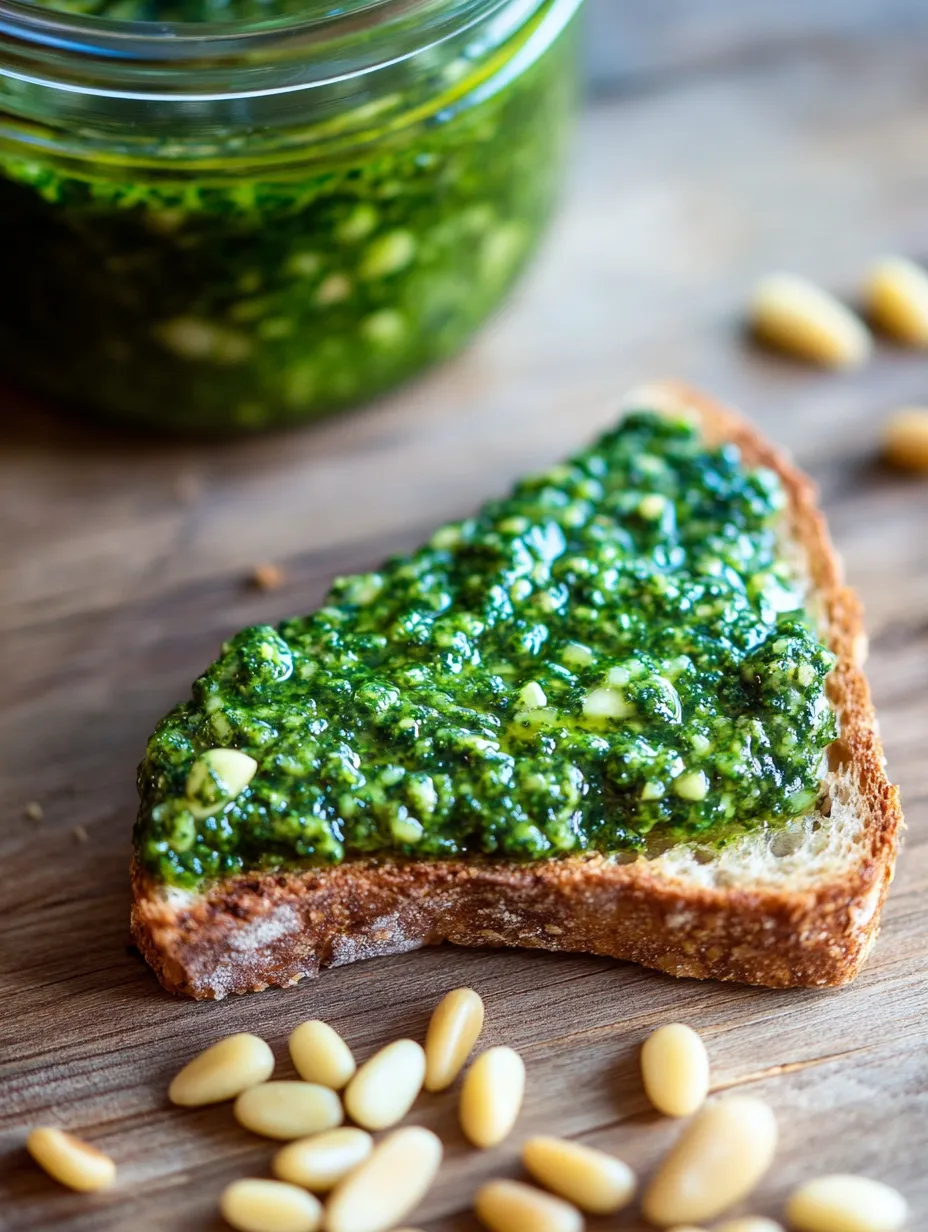 Pin it
Pin it
A homemade wild garlic pesto perfectly captures the unique taste of spring. The combination of fresh wild garlic, roasted pine nuts, and savory Parmesan creates a harmonious balance between mild-spicy garlic aroma and nutty notes. This green delicacy transforms any simple dish into something special.
The first time I prepared this pesto, I was surprised by the intense color and wonderful aroma. Since then, it has become one of our spring traditions to gather wild garlic together and make pesto.
Carefully Selected Ingredients
- 180g fresh wild garlic leaves: Should smell intensely of garlic
- 160ml extra virgin olive oil: The quality shapes the flavor
- 80g Parmesan: Aged at least 24 months for intense aroma
- 60g pine nuts: Untreated and natural
- Sea salt: Coarse salt for perfect seasoning
- Black pepper: Freshly ground for a piquant note
 Pin it
Pin it
The Path to Perfect Pesto
- Refine Pine Nuts:
- Toast pine nuts in a dry pan until golden brown. Keep moving them constantly and pay attention to the aroma. Remove from the hot pan immediately.
- Wild Garlic Preparation:
- Thoroughly wash leaves and pat dry. Remove coarse stems and roughly chop leaves.
- Create Base:
- Coarsely chop roasted pine nuts and Parmesan in a blender. Add wild garlic and half of the oil.
- Final Composition:
- Slowly incorporate remaining oil until desired consistency is reached. Season with salt and pepper.
The vibrant green color of the pesto is a promise to the palate. The mild garlic flavor of the wild garlic combines perfectly with the roasted pine nuts and savory Parmesan. The creamy consistency makes it a versatile companion in the kitchen.
In my family, wild garlic pesto is a real favorite. My daughter especially loves it when I spread it on her school sandwiches. The intense aroma always reminds us of our joint collecting trips in the forest.
Versatile Serving Options
The pesto is a true all-rounder in the kitchen. A spoonful mixed with hot potatoes transforms them into a special dish. As a base for bruschetta, it brings Mediterranean flair to the table. Stirred into risotto, it provides a creamy, savory note.
Creative Variations
Replace pine nuts with walnuts or almonds for a more cost-effective alternative. For a vegan version, you can substitute Parmesan with nutritional yeast. A version with sun-dried tomatoes adds additional sweetness and umami to the mix.
 Pin it
Pin it
Optimal Storage
In the refrigerator, the pesto keeps for about two weeks when covered with a thin layer of olive oil. Frozen in small portions, it remains good for up to six months. Ice cube trays are best for freezing.
After years of experimenting with different pesto variations, wild garlic pesto remains my spring favorite. It combines the power of nature with the sophistication of Italian pesto art to create a delicacy that enhances every plate and makes spring tastable.
Frequently Asked Questions
- → How do I identify fresh wild garlic?
- Fresh wild garlic has shiny, green leaves and smells intensely of garlic. Important: Be aware of the risk of confusion with poisonous plants!
- → Can I use different nuts?
- Yes, walnuts or almonds are good alternatives to pine nuts, but they will change the classic flavor profile.
- → How long does the pesto keep?
- In the refrigerator, covered with olive oil, it will keep for several weeks. Alternatively, it can be frozen in small portions.
- → Why toast the pine nuts?
- Toasting enhances the nutty flavor and makes the pine nuts even more aromatic in the finished pesto.
- → Can I use less oil?
- The amount of oil can be reduced, but a certain amount is necessary for good consistency and preservation of the pesto.
